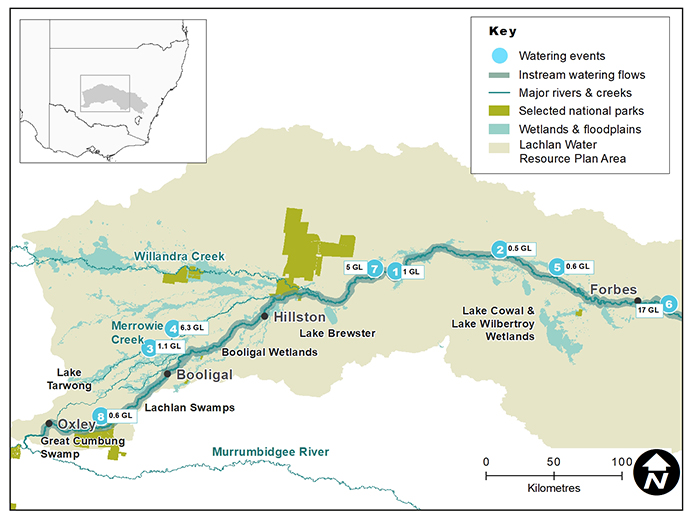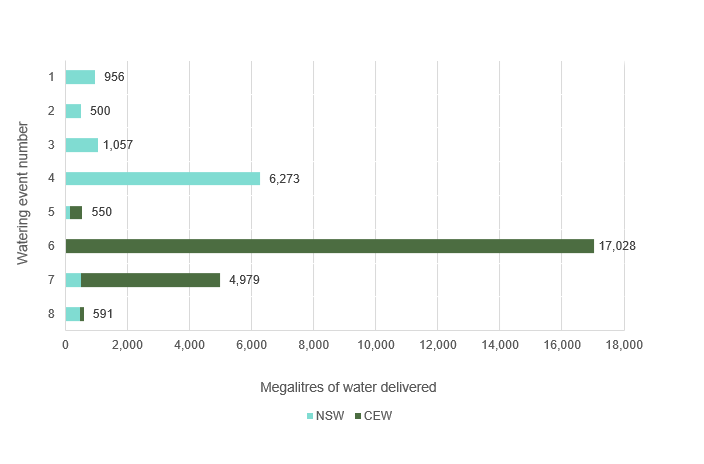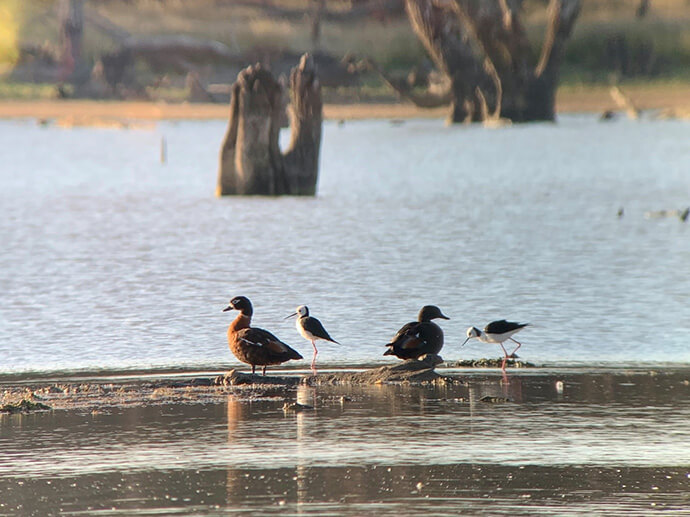The Lachlan valley has an area of 90,000 square kilometres, extending from the Great Dividing Range to the Great Cumbung Swamp on the Riverine plains. Nearly 1300 kilometres of the
1400-kilometre-long river is regulated by water storages, of which Wyangala Dam is the largest at 1220 gigalitres.
The Lachlan catchment remained very dry in 2019–20. Consequently, water for the environment was managed primarily to provide critical refuge and to avoid irreversible impacts on priority native fauna species and wetland vegetation communities.
The focus of water managers in 2019–20, with an expected very dry to dry resource availability scenario, as identified in the Lachlan Catchment Annual Environmental Watering Priorities 2019–20, was on supporting a variety of refuge sites for native plants and animals impacted by drought conditions.
The catchment followed the same low inflow trend from the 2018–19 season with no significant inflows recorded. Wyangala storage started the water year at 26%, dropped to as low as 8.5% in February 2020 and recovered slightly to 16% by June 2020. As a result of low inflows, the catchment stayed in Drought Stage 3 restrictions, with access to carryover allocation suspended and the delivery of water to most creeks off the Lachlan River reduced as a drought management measure by WaterNSW.
Support for refuge sites
The delivery of New South Wales and Commonwealth water for the environment in the Lachlan catchment during 2019–20 provided a variety of refuge types across summer and into autumn for native animals under stress from drought. Many sites remained inundated for at least 4 to 8 months, while deeper wetlands, such as the Cumbung, will retain water to provide an ongoing drought refuge into 2020–21.
Significant outcomes included:
- provision of critical foraging and roosting habitat for a diversity of waterbirds including endangered and migratory species
- provision of habitat to support the Lachlan’s last known population of olive perchlet, a small-bodied native fish
- support for a range of native wildlife and vegetation communities in anabranch systems and creeks
- mitigating against the risk of native fish kills through avoiding poor water quality conditions.
Partnerships with local field ornithologists and private landowners, as well as collaborations with other NSW water agencies, contributed to successful flows across the Lachlan catchment.

Lachlan catchment area map
Watering aims
The delivery of NSW and Commonwealth water for the environment in the Lachlan catchment during 2019–20 focused on avoiding irreversible impacts to priority animal and plant species by building resilience and condition into high priority ecological targets throughout winter and spring.
The watering aims identified in the Lachlan Catchment Annual Environmental Watering Priorities for the 2019–20 water year were largely implemented as proposed under very dry to dry conditions.
Water delivery
This bar chart and table provide a summary of 31,934 megalitres of water for the environment use in the Lachlan catchment during the 2019–20 watering year. Volumes are indicative only. Watering event numbers in the bar chart and table relate to location numbers marked on the map.

Bar chart showing water delivery to the Lachlan catchment in the 2019–20 water year.
Notes: NSW = NSW licensed environmental water; CEW = Commonwealth licensed environmental water.
| Watering event number | Location | Outcomes | Start date | Finish date |
|---|---|---|---|---|
| 1 | Booberoi Creek | Native fish | 01 Jul 2019 | 31 Aug 2019 |
| 2 | Kiagarthur | Waterbirds | 24 Jul 2019 | 15 Dec 2019 |
| 3 | Merrowie Creek to Murphys Lake | Waterbirds | 24 Jul 2019 | 15 Dec 2019 |
| 4 | Merrimajeel Creek to Murrumbidgil Swamp | Vegetation | 11 Aug 2019 | 08 Oct 2019 |
| 5 | Burrawang West Yarrabandai | Connectivity | 13 Aug 2019 | 04 Dec 2019 |
| 6 | Spring pulse: connectivity | Connectivity Vegetation | 17 Sep 2019 | 10 Oct 2019 |
| 7 | Booberoi spring pulse | Vegetation Native fish | 01 Oct 2019 | 30 Mar 2020 |
| 8 | Noonamah | Waterbirds | 28 Oct 2019 | 10 Jun 2020 |
Outcomes
Monitoring of the delivery of water for environment in 2019–20 by the Department of Planning, Industry and Environment – Energy, Environment and Science (DPIE – EES) Water for the Environment Team and partners indicated that a number of ecological outcomes were achieved in multiple locations across the Lachlan catchment.
During spring 2019, a whole-of-system multi-site flow in the Lachlan River provided:
- food and habitat for native fish
- critical foraging and roosting habitats for a diversity of waterbirds
- increased productivity in the river
- support for native vegetation communities.
A diversity of waterbirds including threatened species such as freckled duck, blue-billed duck and brolga, as well as migratory shorebirds such as Latham’s Snipe, common greenshank, sharp-tailed sandpiper and resident wader species, were detected at multiple sites in the mid- and lower-Lachlan. Smaller targeted events to wetlands such as Kiagarthur, Yarrabandai and Noonamah provided critical refuge for a range of waterbird species in an otherwise dry landscape. Due to the very dry conditions the abundance of waterbirds was lower compared with wetter years.
Several additional flows were delivered in the Merrowie, Merrimajeel and Booberoi creeks for vegetation, waterbird and native fish outcomes including strategic drought refuge for threatened eel-tailed catfish and Murray cod.
Water for the environment held in the Brewster weir pool helped provide critical habitat for the Lachlan’s last known population of olive perchlet, a small-bodied native fish which is listed as endangered in NSW.
Low flows below Booligal were supplemented to avoid the river breaking up into isolated pools, mitigate against poor water quality conditions and reduce the risk of fish kills. These outcomes achieved the key planned actions proposed for the 2019–20 water year.
Case study
Thousands of birds found refuge from drought in Lachlan wetlands during 2019–20, thanks to NSW and Commonwealth water for the environment.
Three threatened species – freckled ducks, blue-billed ducks and brolga – were among thousands of birds spotted in wetland surveys over spring and summer.
Water for the environment was delivered to 9 separate wetland sites at different times during the season, supporting habitat for a diverse range of waterbirds.
As well as threatened ducks, Australian shelduck, pink-eared duck, black swan, glossy ibis, red-necked avocet, pied cormorant, Australasian darter and Eurasian coot were sighted.
Migratory shorebirds were also seen in the wetlands feeding in preparation for their migration to the northern hemisphere.
Water lasted on some sites from 4 to 8 months, up until April in many places. One deep wetland in the Cumbung Swamp will likely retain water to provide ongoing drought refuge.
Watering events were conducted in partnership with state and federal government agencies, private landowners and local field ornithologists.

Lake Cargelligo, Australian shelduck and black-winged stilts, among thousands of birds spotted in wetland surveys